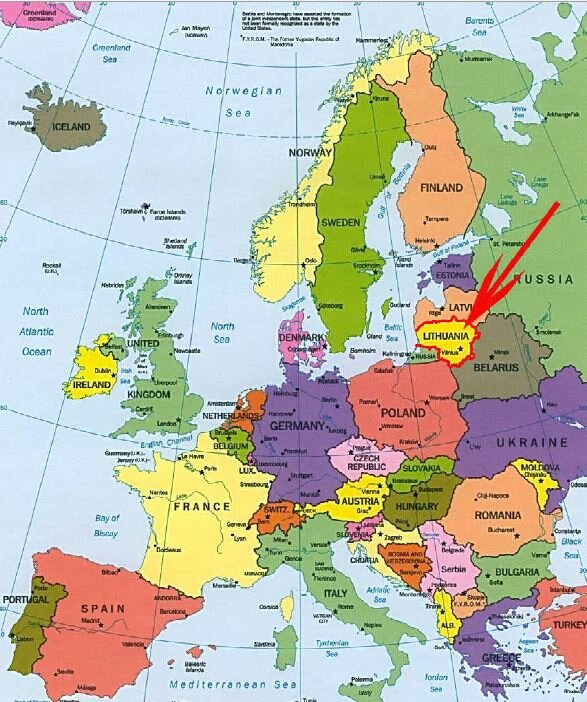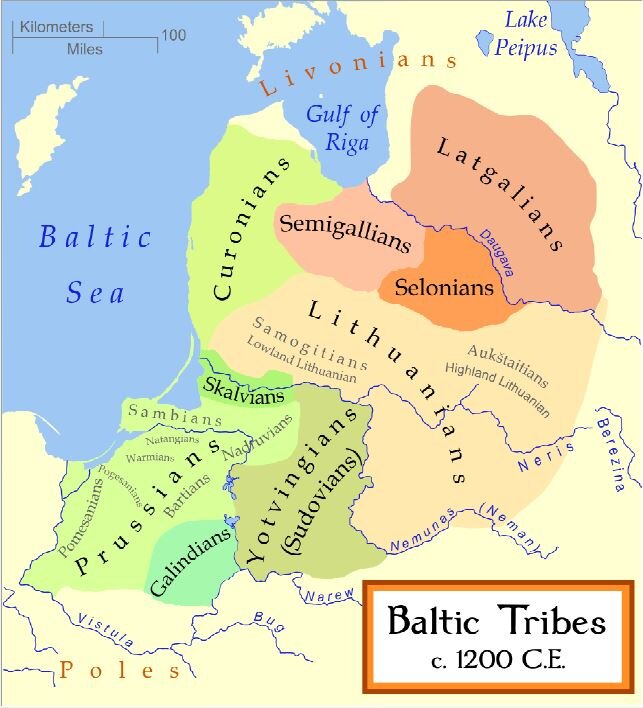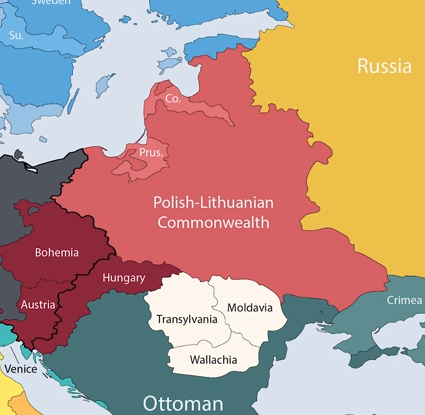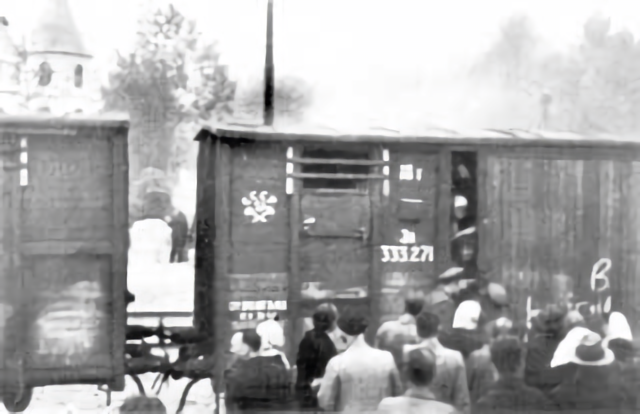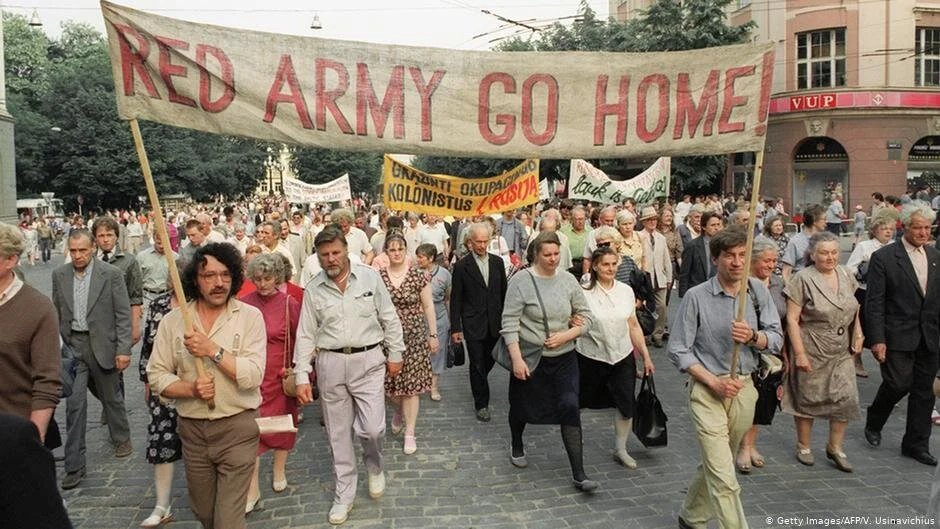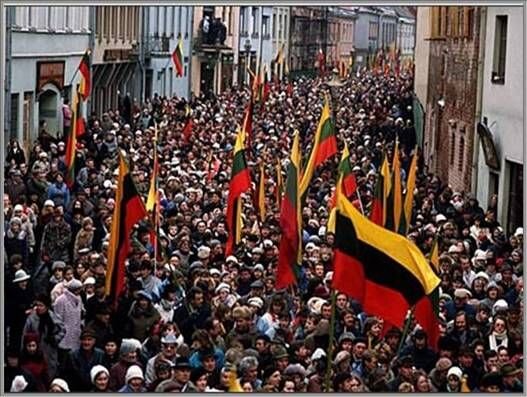History of Lithuania
The often turbulent history of the land where Lithuanian-Americans came from, including the awesome times and the not so great. Told as briefly as possible to not bore you, but with lots of maps and pictures if you like history or geography at all. I’m guessing five to ten minutes, depending on whether you’ve had one beer or two.
Location
Okay, where is Lithuania? It’s in Europe, a small country nestled in the North Central part, on the Baltic Sea. See red arrow on map above.
It’s bordered by Latvia, Belarus, Poland, and Russia. It is part of the European Union and the NATO Alliance, so it’s about as European as you can get. The currency is the Euro, currently about $1.20 = €1.00.
It is considered one of the Baltic States, along with Latvia and Estonia which lie to the north.
Lithuania has a population of 2.8 million people, but there’s more all around the world, so Lithuanians consider themselves as being three million strong. Its tri-color flag (trispalvis) is yellow, green, and red. People often get the yellow wrong, it’s a slightly richer shade.
The Lithuanian Flag
So if you go way back, the Baltic sea was populated by the Baltic tribes for thousands of years. There’s a map below showing where many of them dwelled (Is dwelled a word? Hmm, Google says it is, so we’re good).
Lithuania‘s language (Lithuanian) can be traced back a long way, having roots with archaic features found in the ancient language of Sanskrit, so it is considered to be one of the oldest languages in the world.
The Baltic Tribes circa 1200
In the 1230s, the Lithuanian tribal lands were united by Mindaugas and the Kingdom of Lithuania was created on 6 July 1253.
During the 14th century, the Grand Duchy of Lithuania was the largest country in Europe, including the lands of present-day Lithuania, Belarus, Ukraine, and parts of Poland and Russia, extending from the Baltic to the Black seas. Lithuanians are super proud of this. We used to be h-u-u-g-e!
Cool historic French map of the “L’Empire of Lithuania.” Thanks France! You were awesome too!
Lithuania was the last European country to convert from Pagan religions to Christianity, but the nation still holds some of those pagan traditions very dear to its historical roots.
The Teutonic Knights of Germany tried to pretend Lithuania wasn’t Christian, and attempted to conquer it. At the battle of of Grunwald/ Žalgiris / Tannenberg (whatever language you want to use) fought on 15 July 1410 during the Polish–Lithuanian–Teutonic War, Lithuania led by Grand Duke Vytautas the Great was able to rout a superior force and sent the Teutonic Knights packing, becoming the dominant country in Europe at the time.
Grand Duke Vytautas the Great kicking Teutonic butt (a simulation, actual Instagram image unavailable).
In 1569, the Union of Lublin was signed in Lublin, Poland, and it created a single state, the Polish–Lithuanian Commonwealth, joining the Kingdom of Poland and the Grand Duchy of Lithuania. Poles and Lithuanians became bros, because look to the right, Russia had to be put into check.
But this only lasted until 1795, when after Napolean‘s failed invasion of Russia (never invade Moscow in Winter, lesson #1), Lithuania was invaded right back by the Russian Empire, annexing most of Lithuania's territory. Lithuania pretty much disappeared from the map and the territory remained occupied by Russia until 1918, suffering repression and attempts by Czarist Russia to stamp out the Lithuanian identity, Catholic religion, and language. Several times Lithuanians rose up in revolt only to be crushed by the Russian Army.
Europe in 1795
Finally in 1917, during the Bolshevik revolution, Lithuanians saw an opportunity to break away from Czarist Russia, and on February 16th, 1918 they declared their independence. The Bolsheviks who by that time had taken over, at first resisted losing Lithuania, but got their asses handed to them in some quick battles, so they relented and allowed Lithuania to exit their new Soviet Union.. Below is a map of what Lithuania was supposed to look like from the Soviet/Lithuanian peace treaty..
Map of Lithuania in 1918, but not for long.
But then our old pal Poland, also newly freed from Russia, tried to re-establish the old union (hey bro, remember us?) and invaded Lithuania, occupying the capital of Vilnius (Wilno in Polish). So between the two World Wars, Lithuania was a wee bit smaller, and the capital was relocated to Kaunas. See map below.
But during this time Lithuania experienced a renaissance as its culture was rediscovered, song and dance and the arts flourished. The country began to establish its identity as the country proud of their history but thrilled to be able to practice the Catholic religion and their distinct culture without repression or being told what to do. It was awesome! Freedom tasted great!
Lithuania as it appeared from 1919 to 1939.
It didn’t last long, only 20 years.
In 1939, Nazi Germany and the Soviet Union signed the Molotov-Ribbentrop Non-Aggression treaty, and thus the Soviet Union quickly invaded and annexed Lithuania along with Latvia and Estonia while Germany invaded Poland without consequence.
The Soviets, in order to prevent resistance from the Lithuanian population, began to gather up all government officials, professors, teachers, prominent merchants, business leaders, and their entire extended families, the so-called intelligentsia, and put them on cattle cars and deported them thousands of miles away to labor camps in Siberia. Often rounded up in the middle of the night with no belongings, many died en-route from exposure to the cold. Those who survived were forced to work and live in harsh conditions. They were not allowed to return to Lithuania until 1954 after Josef Stalin died. This has often been considered the Lithuanian Holocaust.
People being loaded onto cattle cars for deportation to Siberia.
In 1941 Nazi Germany broke the treaty and launched a surprise invasion of the Soviet Union, occupying Lithuania along the way, and putting Lithuanians under Nazi rule. Some Lithuanians, having secretly fought the Soviets, now turned their attention to fighting the Germans. But the invasion led to the second Lithuanian Holocaust, as thousands of Lithuanian Jews, Gypsies, LGBT, and mentally ill were gathered up in ghettos in the cities, and then sent by train to concentration and death camps. Others were executed on the spot, or in secret prisons like the infamous Ninth Fort.
In 1944, the Soviets retook Lithuania from the Germans as the tide of World War 2 turned, and reoccupied the country, annexing it and calling it LTSR, one of the fifteen republics of the Soviet Union. One nice thing was that the capital of Vilnius was returned to Lithuania, but that was about it.
Lithuania as part of the Soviet Union in 1945.
Lithuanian partisans waged a guerrilla war against the Soviets from 1944 to 1953, fighting from the forests of Lithuania. But ultimately the Soviet Union committed several divisions and finally put down the uprising.
Though occupied again, Lithuanians still yearned to be free of Soviet occupation and repression. Really, Lithuanian were just plain sick and tired of being occupied.
Then finally, during the Glasnost period of Russia in the late 1980’s, Lithuania saw an opportunity to rekindle the hope for independence, and as the Polish Solidarity movement began to succeed down south, Lithuania too had their Sąjūdis movement for independence. On March 11th 1990, the Act of the Re-Establishment of the State of Lithuania was signed. So we Lithuanians get to celebrate TWO independence days! How neat is that?
But not so fast. The Soviets tried to put down this independence.
Mikhail Gorbachev called the Act of Independence illegal and the USSR demanded revocation of the Act and began applying sanctions against Lithuania including an economic blockade. In addition, on January 13, 1991 Soviet forces stormed the Parliament building in Vilnius along with the Vilnius TV Tower. Unarmed civilian Lithuanians confronted Soviet soldiers. Fourteen people were killed and seven hundred injured in what became known as the January Events.
After international condemnation, Gorbachev decided to call back the troops.
On February 11, 1991, the Icelandic parliament voted to confirm that Iceland's 1922 recognition of Lithuanian independence was still in full effect, as it never formally recognized the Soviet Union's control over Lithuania, and that full diplomatic relations should be established as soon as possible (Thank-you Iceland for being the first to recognize us).
They were followed by Denmark, Slovenia and Croatia, and Latvia. The tide was rolling. Lithuanian independence recognition was then reconfirmed by the United States on September 2, 1991. President George H.W. Bush announced that if the Soviet Union were to use armed force against Lithuania, the U.S. would react accordingly. Finally, on September 6, 1991 Lithuania's independence was recognized by the Soviet Union. We were free at last!
The last thirty years have been amazing as Lithuania has become a modern European country, but retaining that old country look. Tourists love the old castles from those historical periods. The food and beer are great too.
Modern Vilnius
The Castle at Trakai. Looks just like the mural in the Pool room, right? Pretty cool place to visit too.
A lot of other stuff happened before, during, and after, but that’s for another web page. Hope you weren’t bored. Thanks for reading. Quiz at the bar.
Oh, and if you want more, here’s a link to a YouTube video called Lithuanian History Rap (Šventinis bankuchenas - Lietuvos istorijos repas). It’s in Lithuanian, but it comes with English subtitles. It’s pretty cool, highly recommended.
